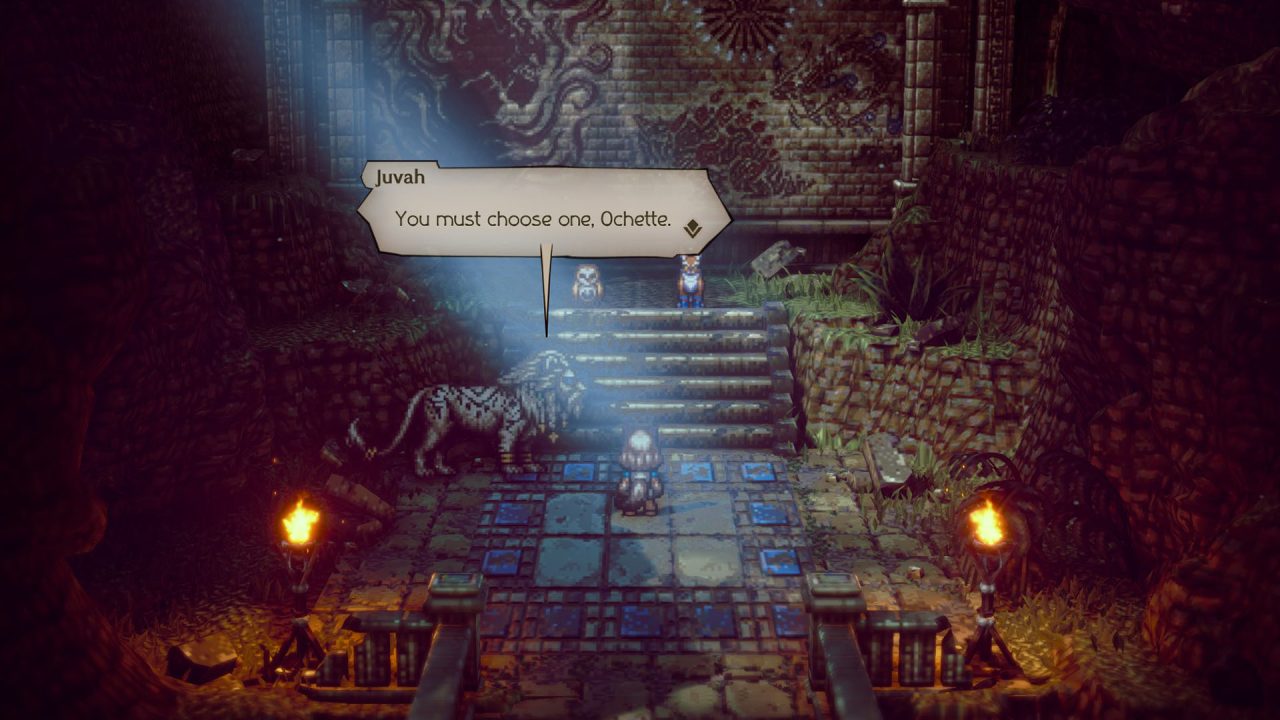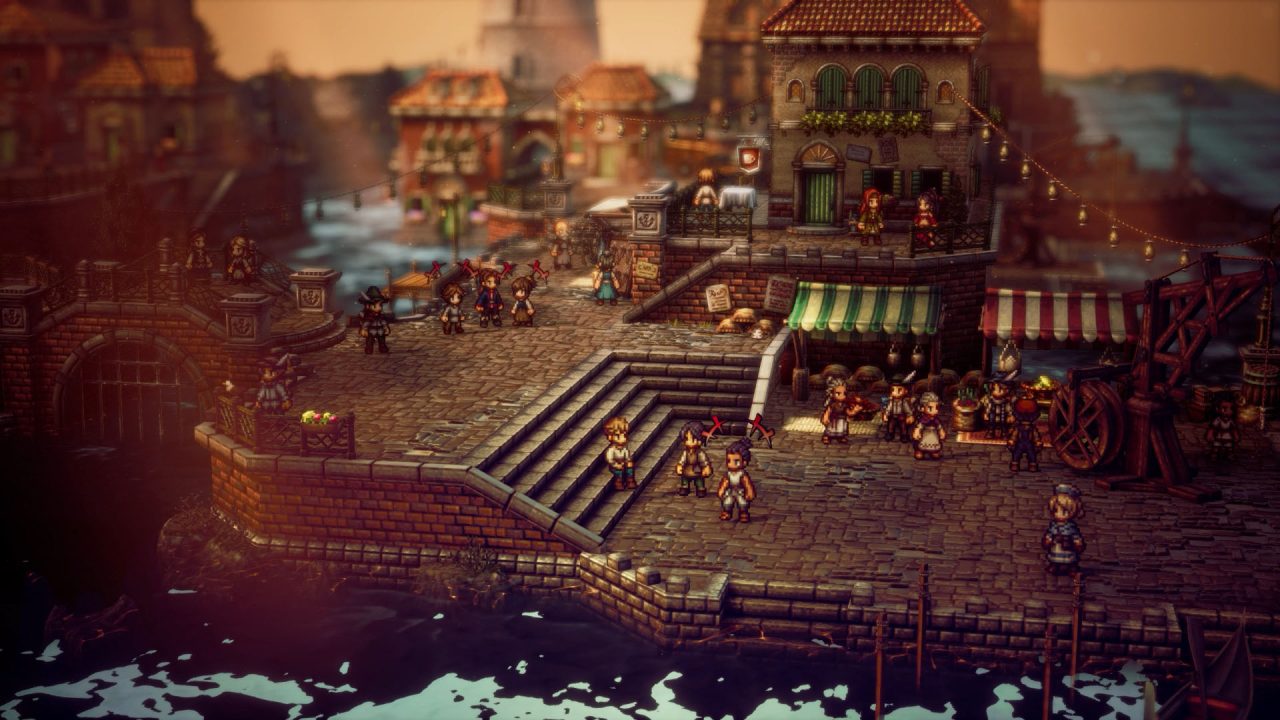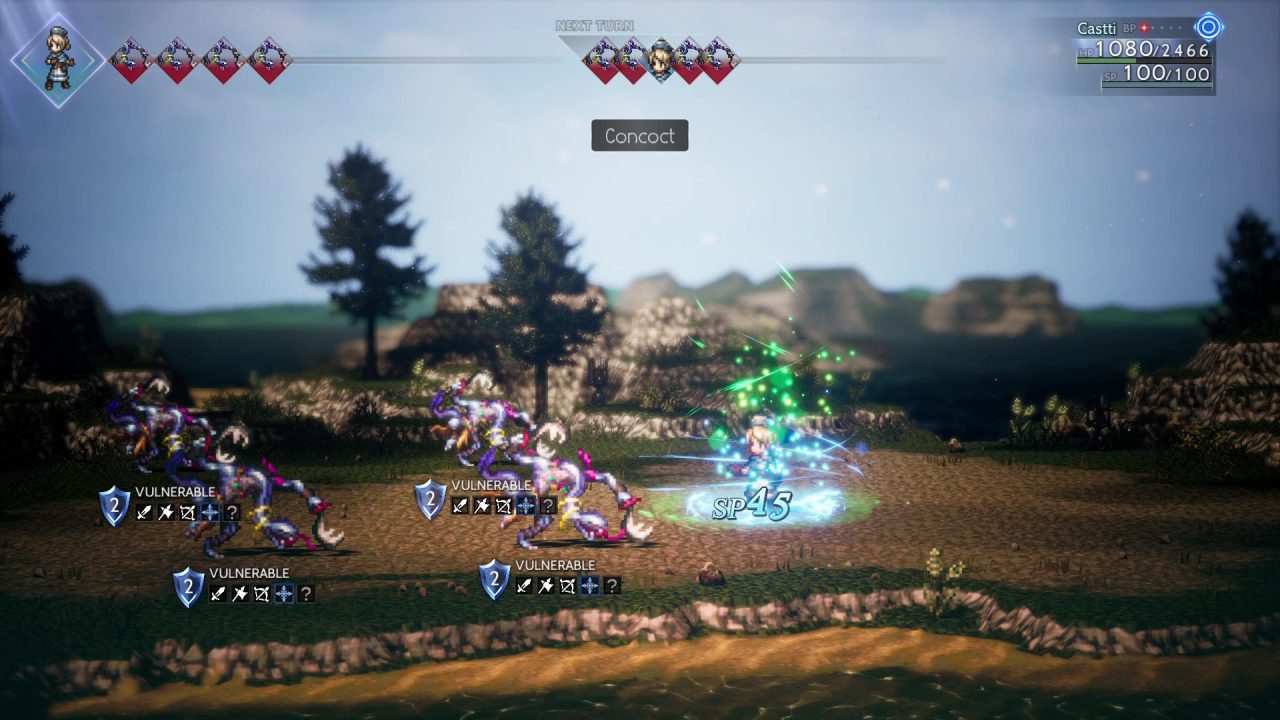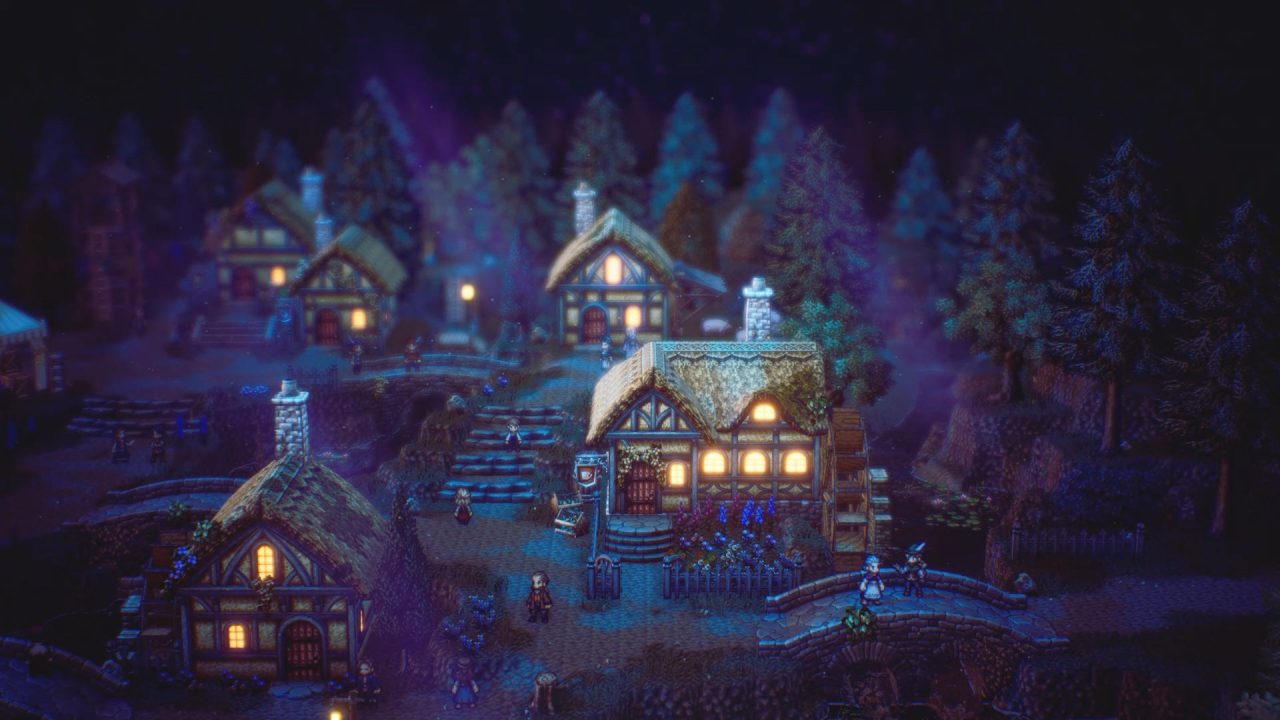I did a funny thing the minute I finished Octopath Traveler II: I booted up the original Octopath Traveler and played around on my old save file.
It wasn’t as good as I remembered.
That’s not really a criticism of Octopath Traveler. Instead, it reminded me of something remarkable about that game—it evoked the memory of how I first felt when I played a lot of the old classics. When I was eight, I felt like the backgrounds of games like Chrono Trigger and Final Fantasy IV had a beautiful depth of field, even if they didn’t. The synthesized scores sounded grand and operatic at the time, and it didn’t even occur to me that the instruments weren’t real. They all seemed incredibly challenging to me, too, even if most of those games are a breeze for me nowadays. Octopath Traveler sounded like my memory, it looked like my memory, and oh boy, did the difficulty match my memory. It made me feel like an eight-year-old sitting on my floor, staring up at my 20-inch CRT TV again. I adored it.
After just a few hours with Octopath Traveler II, I didn’t have quite those same feelings. Instead of evoking my memories of the classics, I just felt like I was playing Octopath Traveler again. It made me feel like the sequel wasn’t doing enough to distinguish itself. When I got past those first hours, though, I realized I was wrong. While it looks and sounds and plays the way I remember the original, Octopath Traveler II takes everything good about the first game, turns it up to 11, adds a few quality-of-life updates, and is, in fact, the superior game overall.
Perhaps the most significant improvement is the storytelling, though some of the issues with the original are still present. As I noted in my preview, the premise is the same. You start out by choosing one of the eight playable characters as your protagonist, play through their first chapter, then go to recruit the rest and play through their stories as well. While I might have been less compelled by the opening hours than I’d like, the stories each get better as they go along, and I was impressed with all eight of them by the end. I was touched by Agnea’s desire to become a star; I cheered when she put a smile on people’s faces. I felt Osvald’s pain and rage over the loss of his wife and daughter and wanted to see his revenge through to the end. I was particularly taken with both Castti and Temenos’ stories, two healers with vastly different personalities whose great character work and compelling mysteries drive their stories forward.

That’s what really sells the stories this time: the writing and the characters. Each of the eight has a strong personality, whether it’s Partitio somehow selling me on the potential of capitalism done right to help prevent poverty, or Hikari’s stoic kindness, they all jump off the screen making the world that much more vibrant. Their stories are filled with excellent characters, too. Interacting with Hikari’s brilliant strategist Kazan is just as fascinating as watching the pure, pious Sanctum Knight Crick’s fun interplay with Temenos’ more dubious faith. Even the NPCs in the towns have whole, rich backstories if you interact with them. Everything feels interconnected, and the level of detail and world-building is astounding.
They’ve also made a fair number of changes to how stories roll out in Octopath Traveler II. Some characters have more chapters than others, you might have multiple paths to go down within each chapter, and sometimes there’s not even any combat in the individual chapters. This adds additional variety that the first game lacked.
What people are probably most interested in, though, is how much the characters actually interact with each other and are involved in each others’ stories. In the first game, it was a little odd when it seemed like the other characters just weren’t there during someone’s story, but it didn’t bother me much. Truthfully, not much has changed here, though Team Asano has added enough to satisfy me personally. Characters are still weirdly absent during others’ stories, but there are many more “Travel Banter” sections, similar to Tales skits, where the characters talk about the story’s events. They’ve also added “Crossed Paths” chapters where two characters share a short story segment where they interact. Finally, after you clear every other chapter in the game, there’s a “Final Chapter” that involves all the characters, ties together some loose threads, and makes the connections between the individual stories a bit clearer and more obvious. While I didn’t necessarily love the story in the Final Chapter, it’s a delight to see all the characters on screen together interacting, and it makes me wish they’d done a little more of it throughout the game. Still, I think they’ve done enough to allay my concerns.

One of the most unique things about the storytelling is that you can experience the stories in almost any order, which gets to one of my favorite things about Octopath Traveler II—the freedom of exploration. Outside of a few areas, you have access to essentially the whole map as soon as you clear the very first chapter. I spent a ton of time exploring the nooks and crannies of the world, clearing out optional dungeons, finding new jobs, and being delighted when enemies smacked me down after I got too ambitious and ventured into danger. You even get a ship to sail around in this time. There’s more to do here than in the previous game; each area is simply bursting with secret alcoves and new discoveries.
That’s true in towns, too, and the newly added day and night cycle gives you additional things to do. Besides changing the music and the look—both of which I’ll gush about in a moment—it also changes the characters’ “path actions.” The path actions allow you to do things like get more information from the townspeople, grab an item from them, bring them along into battle, or even duel them. Hikari can fight people during the day or bribe them for information at night, for example. While I found this a little “bloated” in the early hours, I eventually found it incredibly engaging. Octopath Traveler II does an excellent job of always giving you something to do, a new item to discover, or a new person to bring along. I constantly felt like I was progressing, and the different path actions are a big reason why.
While the exploration is great, it’s really the combat that I love the most in the Octopath Traveler series, and it still delivers in spades. For those who haven’t played the first, Octopath Traveler II is a fully turn-based affair, and you can see your turn order for both the round you’re in and the next. The enemies start with a shield that should be broken by attacking their weaknesses. When the shield breaks, they lose their turn and become weak so you can do massive damage. Adding additional strategy is the BP system that builds for each character. Expending your BP makes your moves more powerful, and you generally want to burn your BP while a boss is weak to dish out maximum punishment.

There are only a few new additions here, and the most important one is the “Latent Power” gauge that charges when you take damage or break an enemy, which gives your teammates access to more powerful skills. For example, when you fill up Partitio’s gauge, you can fill his BP gauge (a personal favorite of mine). There’s also the ability to set the battles to 2x speed, which I had on the entire game, making the snappy combat feel even quicker. The developers took what is, in my opinion, the finest turn-based combat in the genre’s history and made it even better. The level of strategy and options you need to employ in even random battles is a delight from start to finish, and I will never be anything less than satisfied when the sound effect for breaking the enemy plays on my TV.
There is an equally rich job system to go along with the excellent combat. It mostly works the same way as the first, too. Each character starts with a base class (like Warrior on Hikari) and has unique skills to use in battle. You also earn passive skills the further you level them up with the job points you earn in battle. This time around, you unlock two EX skills by finding shrines scattered about the world or clearing a character’s chapter, but these only apply to a character’s base job. After you find the “guild” for each job, you can also equip a secondary job and maintain any of the passive supports earned in that job across others. You can actually equip the same secondary job on up to three characters this time around, assuming you meet the requirements of the guild to give you an additional class emblem. There are even four “secret” jobs that I won’t spoil, but they’re pretty delightful.
For the base jobs, the skills are a little different, though they mostly function the same; job combinations from the original game will still serve you well here, but there’s enough of a difference that it doesn’t play exactly the same. It’s still a blast to play around with different combinations to figure out what works. Some synergize better than others. After I got absolutely destroyed with one build, there was nothing more satisfying than finding exactly the right setup and taking down the most powerful enemies in the game.
Despite all the praise I’m showering on Octopath Traveler II, there are some tiny irritations that hold the game back. The sidequests, for example, while significantly better written than the previous game, can still sometimes be frustrating to complete. There are no waymarks for them, the game doesn’t give you much indication of how to complete them, and you really need to explore every single option available and talk to every possible NPC to clear them. I know it’s a decidedly old-school idea, which seems appropriate. Some people might appreciate it, but especially when I was trying to beat the game for review, I found this a little annoying.

I’m confident no one will like the fact that you still can’t take your chosen protagonist out of the party until you’ve cleared their final chapter, and you can only change party members at taverns in town. Inventory management can be a pain too. As I was constantly flipping people in and out of my party, I had to scroll through a huge inventory list to find the equipment I wanted every time, and I wish there were a way to save my favorite accessories at the top. Oh, and if someone isn’t in your party, they don’t earn experience or job points. Look, none of this is that big of a deal, and I appreciate the quality-of-life adjustments Team Asano made, but it makes the game a little less pleasant to play. I hope they take a look at some of these things in the inevitable sequel.
But do you know what I have absolutely no complaints about? The way this game looks and sounds. As blown away as I was by the original, Octopath Traveler II surpasses it. The beautiful particle effects, the stunning HD-2D environments, and the newly added dynamic camera all come together to make this game feel truly cinematic at times, and it’s just an absolute joy to look at. The day/night system helps, too—the crisp, shimmering water looks even more stunning in the moonlight. Team Asano has moved the ball forward so much that Octopath Traveler looks positively pedestrian next to this game.
The music isn’t necessarily an enormous leap forward, but how much better could it get? There’s a reason there are a multitude of arrangement albums for the original: the music is out of this world. The swelling orchestral music from the original somehow managed to capture the spirit of the 16-bit era while also being much bigger, much fuller, and so much more exciting. But have you heard the new boss theme yet? Go listen to it. Now. It’s so good. Plus, the tracks just have more variety this time around. I particularly love the western mixed with the 1980s sitcom music littered throughout Partitio’s story. I’m listening to the limited number of tracks that are already available right now, and let me tell you, it just gets better.
Memory is a funny thing. It can distort our perceptions of our lives, and our experiences aren’t ever really what we remember. Even when the specifics of a memory fade away, though, the feeling of the moment remains. Octopath Traveler II captures the feeling of those memories beautifully, and it’s not a game I’ll soon forget.



